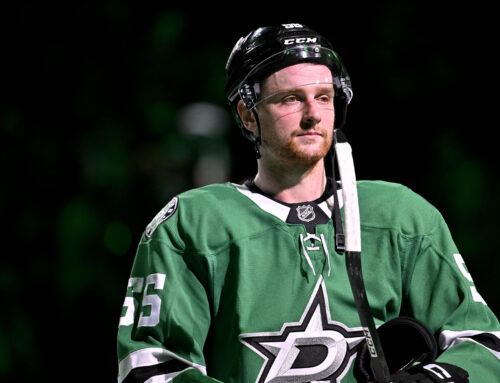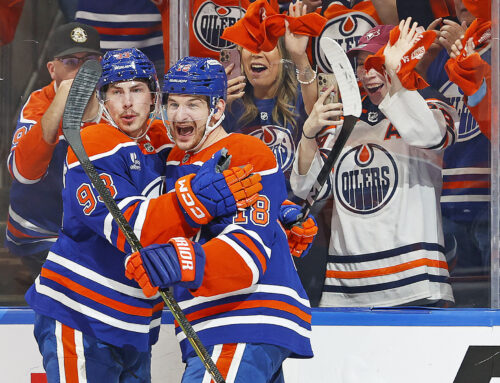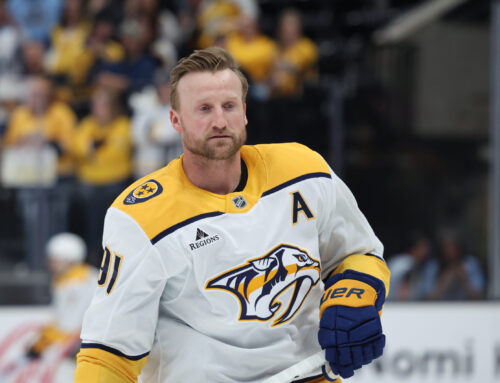
With the regular season behind us it’s a good time to look at our preseason predictions to see where we hit and where we missed. Last week we examined how several top-end rookies and breakout candidates fared against our prognostications. This week we’ll look at those we thought might rebound from a less-than-stellar 2015-16 as well as those for whom we predicted decline, and compare with their on-ice performances.
Top Western Conference Rebound Candidates (original article here)
Radim Vrbata, Arizona – RW
Back in Arizona Vrbata rebounded dramatically. With a 28-point increase accompanying his move south from Vancouver, the franchise great provided leadership for a maturing squad and hastened the development of rookie linemate Christian Dvorak. While Dylan Strome wasn’t quite ready, Vrbata’s presence with Max Domi, Tobias Rieder, and Brendan Perlini particularly on the power play, likely accentuated their production during another difficult year in the desert. The 15-year vet exceeded our 40-point expectations leading the Coyotes in goals (20), assists (35), and points (55) while finishing second to OEL with 15 power play points.
Nail Yakupov, St. Louis – RW
Unfortunately no for the 2012 NHL Draft’s first selection. We thought a potential spot on the McDavid line and an Oiler desire to foster elusive success by giving Yakupov consistent minutes might bring better production. Instead he was dealt in early October to the Blues for ECHL forward Zach Pochiro and a conditional 2017 third round pick. St. Louis brought injuries, scratches, and even further regression from his 23-point final Edmonton campaign with just nine points (3 G, 9 A) in 40 games and just 10:39 of ice time per game.
Mathieu Perreault, Winnipeg – C/LW
Perreault slightly increased scoring in 2016-17 as his 45 points in 65 games (0.69 per contest), bested the previous year’s 0.58. We predicted at least 40 points and a 0.65 per-game minimum. After November and January trips to injured reserve he was particularly productive as the campaign closed. The 29-year-old, eight-year vet went on a red-hot 11-game, 17-point (six goals, 11 assists) run in March/April including seven power play points while splitting even-strength time between the Laine – Little and Scheifele – Wheeler lines.
Eric Staal, Minnesota – C
It was a major rebound for Staal who obliterated his previous campaign’s 39 points with 65 (28 G, 37 A) in Minnesota, more than doubling his power play points (from seven to 16). We predicted a recovery from his 2015-16 with the Rangers and Carolina but undershot it with our 40-50 point prediction. A major factor in Minnesota’s highly successful first two-thirds of 2016-17, Staal’s presence helped boost production for primary linemates Charlie Coyle and Nino Niederreiter who each saw 14-point increases. A big jump from the six points Staal picked up skating mainly with Jasper Fast and Kevin Hayes during the final twenty Ranger contests last spring.
Patrick Wiercioch, Colorado – D
Does a move from five points to twelve qualify as a rebound? Not a strong one. Wiercioch was in the worst possible spot to increase production, totaling four goals and eight assists with zero power play points on the league’s lowest scoring squad by far. Being a blueliner on what was also by far the most porous squad was strike two. Many healthy scratches brought strike three in his 57-game campaign. Wiercioch didn’t approach his Ottawa stats of three and four years ago, particularly the highly impressive scoring totals per 60 minutes at even strength as we had hoped. A change of scenery (again) could help, so we’ll have to see where the 26-year-old restricted free agent lands in 2017-18.
Adam Larsson, Edmonton – D
With a one-point jump in scoring, there was no offensive rebound, but Larsson was presumably obtained for his defensive prowess. His move from plus-15 to plus-21 was positive in that regard. Interestingly though, his 48.13% offensive zone starts marked a large increase over his 31.82% last year and, while his ice time dropped by 2:24, his shots increased from 65 to 83. Without a doubt this had much to do with Edmonton’s high-flying style compared with New Jersey’s low-scoring game. While we thought the big blueliner’s power play time might increase to more than a minute per game for the first time in five years, it dropped to 0.11. Perhaps more surprisingly, his shorthanded play also dropped, from 60.2% of the Devils’ total 2015-16, to 34.0% for the Oilers. Larsson’s peripherals increased with hits moving from 163 to 251, and blocks from 148 to 159. With a shifted role in a different system his contributions aren’t entirely captured by statistics, but you can’t argue with the Oilers’ success.
Cam Talbot, Edmonton – G
Talbot was the backbone of a highly successful Edmonton campaign and made statistical increases across the board. Take a look…
|
season |
G |
GS |
record |
saves |
GAA |
SV% |
SO |
minutes |
|
2016-17 |
73 |
73 |
42-22-8 |
2,117 |
2.39 |
.919 |
7 |
1,946 |
|
2015-16 |
56 |
53 |
21-27-5 |
1,648 |
2.55 |
.917 |
3 |
1,511 |
A few playing-time-dependent stats here but hey, Talbot played a whole lot. He proved ridiculously durable, dropping his GAA from 2.55 to 2.39 despite logging over a thousand more minutes and twenty more starts (73 total) than in 2015-16. His save percentage also nudged from .917 to .919, very close to our 92% prediction. Rebound, breakout, whatever you want to call it Talbot was huge. And while we speculated that a revamped blue could be a big help, Edmonton yielded 35 less goals than in 2015-16 without a huge decline in shots against per 60 minutes with 30.67 vs. the previous campaign’s 30.70. Much of this can be attributed to Talbot’s continued development.
Honorable Mentions:
Brian Campbell, Chicago – D
Strangely enough, Campbell’s stats declined by a good margin. With a Chicago squad that slightly eclipsed the offensive output of his 2015-16 Panthers (240 goals vs. 232), he saw a nearly four-minute drop in ice time per-game. Campbell’s five goals and 12 assists marked a significant downward change from his 34-point final Florida campaign and was his lowest total since his 11-point, 53-game 2003-04 Sabre campaign. The 37-year-old also took 25 less shots-on-goal (from 99 to 74) and saw his plus-minus decrease from plus-31 to plus-12. While we envisioned Campbell on a pairing with Brent Seabrook, he spent the more than twice as much time skating with defense-oriented Trevor van Riemsdyk at even strength.
Ryan Getzlaf, Anaheim – C
Getzlaf enjoyed an offensive bump – from 13 goals and 50 assists in 2015-16, to 15 goals and 58 assists last year. Although, in line with our predictions, his shot success rate increased somewhat from 7.3% to 10.9% we didn’t see a significant uptick in goals as hoped. But we called his 70+ year, as his 73 points beat the previous campaign by ten. All this while taking 40 fewer shots (dropping to 138 from 178, his least in a non-lockout year since a 67-game 2010-11), seeing a minute-and-a-half ice time dip (19:30 from 21:04), and skating in three less contests (74 from 77).
Marian Hossa, Chicago – RW
Hossa had a solid 12-point increase to 45 from 33, doubling his goals (13 to 26) while taking 24 fewer shots. We were right on target, predicting 40-45 points, but saw the jump as a product of him skating on a revitalized Jonathan Toews line. While Hossa worked on the power play most frequently with Toews and Richard Panik (leading to five goals and six assists on the man advantage, an increase of three goals) the 38-year-old usually lined up at even strength with Marcus Kruger and Ryan Hartman, and more productively with Artem Anisimov and Artemi Panarin.
Marian Gaborik, Los Angeles – RW
An almost identically disappointing year for Gaborik…
|
year |
games |
goals |
assists |
points |
PIM |
PPP |
SOG |
TOI |
|
2016-17 |
56 |
10 |
11 |
21 |
18
📢 advertisement:
|
5 |
123 |
14:47 |
|
2015-16 |
54 |
12 |
10 |
22 |
20 |
4 |
142 |
14:56 |
He nearly hit 60 games, but halved our 20-goal, 40-point forecast with the lowest scoring campaign of his 16-year career. Missing two months after breaking his ankle at the World Cup didn’t help. Much from replacing Milan Lucic’s production in the top-six, by year’s end his role devolved into a fourth-line spot skating with Kyle Clifford and Nic Dowd and he saw several healthy scratches. Looking at off-season knee surgery and questionable to start training camp he shouldn’t be counted on again for a major increase.
Top Decline Candidates (Original article here)
Patrick Kane, Chicago – RW
Everyone saw this one coming. Kane finished tied for second in the league with 89 points. He matched Sidney Crosby and landed below just Connor McDavid, and still slipped 17 points off his Art Ross-winning 46 goals and 60 assists of 2015-16. It was inevitable and indeed the surest of bets after such an amazing previous year.
Carl Soderberg, Colorado – C
A huge decline. Beyond the avalanche (sorry) of Colorado problems Soderberg’s production hit the floor, from 51 points (12 G, 39 A) to just 14 (6 G, 8 A). From a top-six role and solid power play minutes to the fourth line. Losing five minutes per-game of ice time was another factor in Soderberg plummeting from 0.62 points-per-game to 0.18. As predicted, he slid to fourth (fifth if you count Tyson Jost’s six-game stint) among Colorado centers with 13:27 in TOI behind MacKinnon (19:56), Duchene (18:18), Jost (15:40), and Grigorenko (14:05). He also had a third consecutive campaign of decreased shooting percentage with just 4.7%, second-worst in the league to Riley Sheehan among centers taking at least 100 shots.
Mikkel Boedker, San Jose – LW
Another big decline here with nearly half the points (from 51 to 26 – a 0.32 PPG average from 0.64), a crazy power play point drop from 19 points to one, 44 less shots, and a greater than four-minute slide in minutes-per-game from 18:31 to 14:20. After finishing second in power play minutes to only Alex Ovechkin among forwards with 316:04, Boedker’s time on the man advantage was more than halved with a stronger San Jose squad to 124:36. Under contract for three more years at $4M each, Doug Wilson must be questioning last July’s signing of the 27-year-old, former eight-year Arizona stalwart.
Blake Wheeler, Winnipeg – RW
Wheeler lost just four points off his 2015-16 totals, slipping from 78 to 74 while maintaining a 0.90 points-per-game average. The decline was exclusively in assists as he hit the 26-goal mark for a third consecutive year. In addition, his power play points increased from 17 to 21 including 13 while skating with Scheifele. While he continued last year’s production when working with Scheifele at even strength, tallying 26 points with various third wheels, his most productive line was with Perrault and Little with whom he racked up 11 points. It was a remarkably similar year for peripherals which saw Wheeler take a nearly identical amount of shots (259 compared with last year’s 256), and dish out 100 hits and 51 blocks (vs. 96 and 56 respectively)
Francois Beauchemin, Colorado – D
A major drop off for the Avalanche assistant captain who totaled 18 points (five goals, 13 assists, with three power play points), about half of last year’s 34-point production, despite finishing third among Colorado blueliners with 21:30 in ice time per-game and leading the pack with 81 games played. Predictably, his shot percentage also sunk from 6.3% to 3.8%. Showing just how bad it was in Colorado, Beauchemin’s minus-14 was second-best among Avalanche defensemen playing more than 40 contests, with Erik Johnson’s minus-six in 46 games taking top honors. His blocked shots total also lost an even hundred, moving from 256 to 156.
Brent Seabrook, Chicago – D
Seabrook saw a ten-point decline, from 49 to 39, including 11 fewer goals and an additional 11-point drop (25 to 14) on the power play. This despite just a small slip in team percentage of man-advantage ice time, as he skated on 55.9% of Chicago’s power play opportunities compared with 58.6% last year. We pretty much pegged it when identifying 2015-16 as a career year for the 12-year vet, who approached similar totals only once prior with 48 points, 20 on the power play, in 2010-11. We didn’t nail it in predicting Brian Campbell’s influence on a scoring decline, as his 33.7% share of Blackhawk power play ice time generated just five points and no significant change in Seabrook’s TOI.
Pekka Rinne, Nashville – G
Rinne wasn’t bad.
|
season |
G |
GS |
record |
saves |
GAA |
SV% |
SO |
minutes |
|
2016-17 |
61 |
61 |
31-19-9 |
1,757 |
2.42 |
.918 |
3 |
3,568 |
|
2015-16 |
66 |
66 |
34-21-10 |
1,744 |
2.48 |
.908 |
4 |
3,896 |
With rookie Juuse Saros getting in 21 games and providing an effective alternative to his fellow Finn, the more frequently rested 35-year-old vet saw a nice save percentage gain and slight decrease in goals-against-average along with three less wins. In spite of the five fewer contests and 328 minute dip, Rinne made a few more saves. Perhaps his stats will sustain going forward if Nashville increases the time share, an appropriate strategy for an aging but effective goalie.
Honorable Mentions:
Anthony Duclair and Max Domi, LW – Arizona
Were it not for his fight-enhanced broken hand we likely wouldn’t be talking decline for Domi. In fact his points-per-game average was identical this year to last – 0.64. But missing 23 games brought his scoring total down to 38 points (9 G, 29 A) versus 52 points in 2015-16. Duclair was another story entirely. After a promising, 20-goal, 24-assist year few expected his complete collapse. Punctuated by a long spell in AHL Tucson he tallied just 15 points in 58 games. Duclair went from a plus-12 to a minus-7. From 0.54 points-per-game to 0.26. Twelve power play points to two. You get the picture. Major decline.
Bryan Little, Winnipeg – C
No decline here. Instead we have an increase from 42 points to 47. Little again played limited games with just 59 due to an opening night knee injury on the heels of last year’s fractured vertebrae. Nonetheless, he saw a slight increase in points per game, from 0.74 to 0.80 in 2:02 less average ice time. We thought Scheifele’s ascent would cost Little minutes and thus points. He did skate less. In his tenth year with the Jets/Thrashers he lost over two minutes per game (19:36 to 17:33), and nearly 0:45 on the man advantage (2:57 to 2:15). But Little benefitted from an extra-potent Winnipeg offense which potted 34 more goals than last year (246 vs. 212), including ten additional on the power play (48 vs. 38).
***
Follow me on Twitter @KWcrosscheck
3 Comments
Leave A Comment
You must be logged in to post a comment.





 SEA
SEA CHI
CHI OTT
OTT EDM
EDM DAL
DAL STL
STL ANA
ANA FLA
FLA CBJ
CBJ L.A
L.A

I think I did better on these predictions than on the first bunch, either way thanks for going easy on the massive misses.
No prob! It felt kinda strange critiquing someone else’s predictions, so I hope I did them justice.
I have no complaints. Judging by the number of underachievers I had this year I’m surprised you were able to find anything that we close. Tough spot.